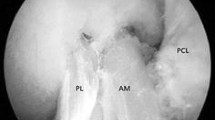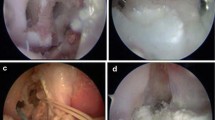Abstract
Recently, double bundle ACL reconstruction, in which the two bundles thought to have different effects on knee kinematics are reconstructed separately, is widely believed to more favorably restore normal knee kinematics than conventional single bundle ACL reconstruction. However, rotational kinematics during physiological movement after double bundle reconstruction has rarely been tested. The purpose of this study was to measure the kinematics of the ACL deficient and reconstructed knees using two different tensioning conditions in double bundle reconstruction, and to examine the effects of each graft on knee kinematics. Six cadaveric knees were used. Six degrees-of-freedom of knee kinematics and the tension of each graft were monitored during simulated knee extension with the ACL intact, resected, and reconstructed under two different tensioning conditions: 50 N on anteromedial bundle and 0 N on posterolateral bundle (AM-favored condition); 0 N on anteromedial bundle and 50 N on posterolateral bundle (PL-favored condition). Tibial translation: After ACL reconstruction, the tibia overcorrected posteriorly in both conditions. Such an overcorrection in the AM-favored condition was larger than in the PL-favored condition. Tibial rotation: The tibia was significantly externally rotated after ACL reconstruction at a low flexion angle in both conditions. However, at a high flexion angle, tibial external rotation was shown only in the AM-favored condition. Graft tension: While total tensions were similar between the two conditions, the AM bundle shared more tension in the AM-favored condition than in the PL-favored condition. A total of 50 N of tension force was assumed to be excessive for normalizing knee kinematics at a low flexion angle even if double bundle reconstruction was used. Additionally, the AM-favored tensioning reconstruction made the tibia rotate externally and translate posteriorly even at a high flexion angle. Further research is needed to normalize knee kinematics after ACL reconstruction, however it is recommended that a moderate tensioning force is applied to the PL bundle and a minimal tensioning force to the AM bundle in double bundle reconstruction to obtain better knee kinematics.









Similar content being viewed by others
References
Amis AA, Jacob RP (1998) Anterior cruciate ligament graft positioning, tensioning and twisting. Knee Surg Sports Traumatol Arthrosc 6:S2–S12
Andersen HN, Dyhre-Poulsen P (1997) The anterior cruciate ligament does play a role in controlling axial rotation in the knee. Knee Surg Sports Traumatol Arthrosc 5:145–149
Arnold MP, Verdonschot N, Kampen A (2005) The normal anterior cruciate ligament as a model for tensioning strategies in anterior cruciate ligament grafts. Am J Sports Med 33:277–283
Brandsson S, Karlsson J, Swärd L, Kartus J, Eriksson BI, Kärrholm J (2002) Kinematics and laxity of the knee joint after anterior cruciate ligament reconstruction. Pre–and postoperative rediostereometric studies. Am J Sports Med 30:361–367
Bylski-Austrow DI, Grood ES, Hefzy MS, Holden JP, Butler DL (1990) Anterior cruciate ligament replacements: a mechanical study of femoral attachment location, flexion angle at tensioning, and initial tension. J Orthop Res 8:522–531
Georgoulis AD, Papadonikolakis A, Papageorgiou CD, Mitsou A, Stergiou N (2003) Three-dimensional tibiofemoral kinematics of the anterior cruciate ligament-deficient and reconstructed knee during walking. Am J Sports Med 31:75–79
Grood ES, Suntay WJ (1983) A joint coordinate system for the clinical description of three-dimensional motions: application to the knee. J Biomech Eng 105:136–144
Hirokawa S, Solomonow M, Lu Y, Lou Z (1992) Anterior-posterior and rotational displacement of the tibia elicited by quadriceps contraction. Am J Sports Med 20(3):299–306
Loh JC, Fukuda Y, Tsuda E, Steadman RJ, Fu FH, Woo SL (2003) Knee stability and graft function following anterior cruciate ligament reconstruction: comparison between 11 O’clock and 10 O’clock femoral tunnel placement. Arthroscopy 19:297–304
Mae T, Shino K, Matsumoto N, Nakata K, Nakamura N, Iwahashi T (2006) Force sharing between two grafts in the anatomical two-bundle anterior cruciate ligament reconstruction. Knee Surg Sports Traumatol Arthrosc Jan 6:1–5 [Epub ahead of print]
Melby A, Noble JS, Askew MJ, Boom AA, Hurst FW (1991) The effects of graft tensioning on the laxity and kinematics of the anterior cruciate ligament reconstructed knee. Arthroscopy 7:257–266
Milne AD, Chess DG, Jhonson JA, King GJW (1996) Accuracy of an electromagnetic tracking device: a study of the optimal operating range and metal interface. J Biomech 29:791–793
Nagamune K, Muratsu H, Hoshino Y, Tanaka K, Kubo S, Yagi M, Mizuno K, Kuroda R, Yoshiya S, Kurosaka M (2004) Non-invasive real-time visualization of the 6DOF of knee kinematics during manual testing. Presented at the annual meeting of the Orthopaedic Research Society, Poster No.557, Washington, DC
Ristanis S, Giakas G, Papageorgiou CD, Moraiti T, Stergou N, Georgoulis AD (2003) The effects of anterior cruciate ligament reconstruction on tibial rotation during after descending stairs. Knee Surg Sports Traumatol Arthrosc 11:360–365
Tashman S, Collon D, Anderson K, Kolowich P, Anderst W (2004) Abnormal rotational knee motion during running after anterior cruciate ligament reconstruction. Am J Sports Med 32:975–983
Yagi M, Wong EK, Kanamori A, Debski RE, Fu FH, Woo SL (2002) Biomechanical analysis of an anatomic anterior cruciate ligament reconstruction. Am J Sports Med 30:660–666
Yamamoto Y, Hsu WH, Woo SL, Van Scyoc AH, Takakura Y, Debski RE (2004) Knee stability and graft function after anterior cruciate ligament reconstruction. a comparison of a lateral and an anatomical femoral tunnel placement. Am J Sports Med 32:1825–1832
Yasuda K, Kondo E, Ichiyama H, Kitamura N, Tanabe Y, Tohyama H, Minami A (2004) Anatomic reconstruction of the anteromedial and posterolateral bundles of the anterior cruciate ligament using hamstring tendon graft. Arthroscopy 20:1015–1025
Yoo JD, Papannagari R, Park SE, DeFrate LE, Gill TJ, Li G (2005) The effect of anterior cruciate ligament reconstruction on knee joint kinematics under simulated muscle loads. Am J Sports Med 33:240–246
Author information
Authors and Affiliations
Corresponding author
Rights and permissions
About this article
Cite this article
Hoshino, Y., Kuroda, R., Nagamune, K. et al. The effect of graft tensioning in anatomic 2-bundle ACL reconstruction on knee joint kinematics. Knee Surg Sports Traumatol Arthrosc 15, 508–514 (2007). https://doi.org/10.1007/s00167-006-0242-3
Received:
Accepted:
Published:
Issue Date:
DOI: https://doi.org/10.1007/s00167-006-0242-3




